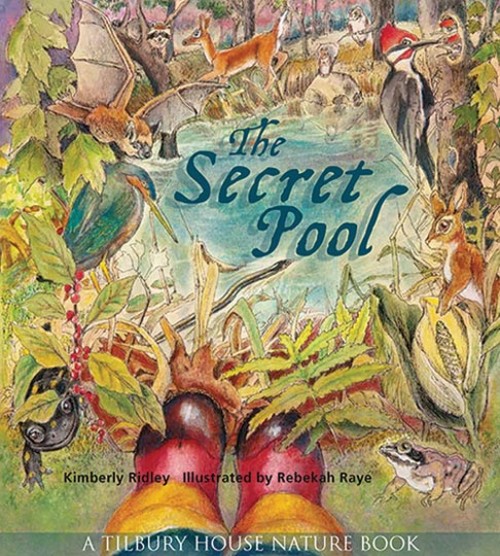by Kimberly Ridley, illustrated by Rebekah Raye
Tilbury House Publishers, 2013
A frog that sounds like a duck. A fairy shrimp that swims upside down. A fat salamander with bright yellow spots. These are some of the inhabitants of vernal pools whose lives are explored in science author Kimberly Ridley’s newest picture book, The Secret Pool. Ridley joined with illustrator Rebekah Raye to create this award-winning book that shares the secrets of a vernal pool, from its early-spring awakening to its late-summer disappearance. The child-friendly text is accompanied by sidebars that tell about vernal pools and their inhabitants in scientific yet easy-to-understand language. The prose is sprinkled with an occasional rhyme (“I am filled with jazzy orange fairy shrimp. Slim and frilly, they swim willy-nilly upside down.”)
The Secret Pool begins with engaging and vivid watercolors. Raye depicts a vernal pool and the forest creatures that live in or visit it. There is no text on this page, but even the youngest book lover will enjoy being encouraged to “find the raccoons” or “count the baby birds in the nest.” As the page is turned, the sidebar reveals that vernal pools are temporary and “can be as small as a puddle or as big as a pond.” On another page, Raye draws a ruler carefully lined up under drawings of the animals to help young readers see, for example, just how big a spotted salamander is compared to a diminutive fairy shrimp.
When Ridley discusses wood frogs, she tells how they become “frogsicles” to survive the winter; how their hearts stop beating and they stop breathing, but thaw out as warm spring weather returns and they hop to vernal pools to lay eggs. Next, a huge swarm (or “congress”) of spotted salamanders swirling in the vernal pool fills the page. Readers are encouraged to visit a vernal pool on a rainy evening in early spring when the light from a flashlight might reveal spotted salamanders that have come to mate. Ridley’s sidebar on fairy shrimp tells us that they eat zooplankton, and a glossary explains this and other terms to young readers.
All of Raye’s paintings effectively complement Ridley’s text, but the ones that show how to tell wood frog eggs from spotted salamander eggs are particularly helpful to budding young naturalists who are lucky enough to find a vernal pool laced with egg masses. Readers are also treated to an almost full-page picture of a rather satisfied looking bullfrog with a tail of a tadpole hanging out of his mouth. A closer look shows other tadpoles in varying stages of development swimming away with fearful looks in their eyes.
“A whisper of wet is all that I am, a small muddy patch on the frosty land,” brings The Secret Pool to a close as Ridley describes the seasonal transformation of a vernal pool from an area of wet muddy leaves into a thriving habitat. The text and illustrations of this book would easily capture the attention of children in kindergarten through third grade.
A suitable accompanying text is Frog Heaven, Ecology of a Vernal Pool (Boyds Mills Press, 2006), written and photographed by Doug Wechsler. Along with great close-ups of frogs and salamanders, Wechsler’s text (intended for older readers) provides even more information about the ecology and importance of vernal pools.


